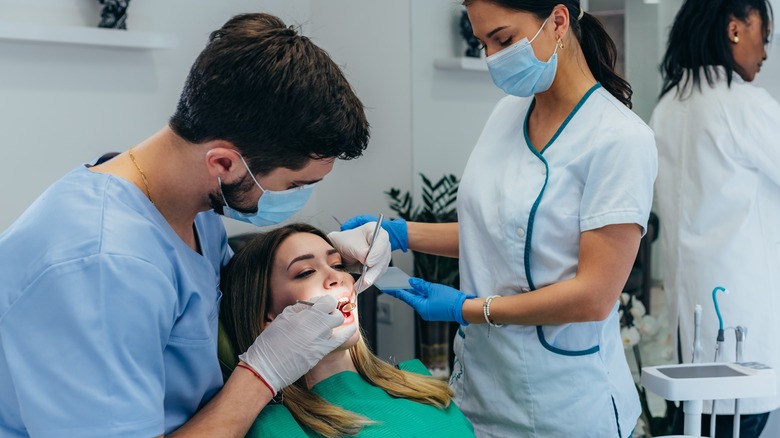Can Cavities Come Back After A Filling?
Many of us know the discomfort of sitting in the dentist's chair and waiting for our cavity filling procedure to be over with. Once that cavity is filled, you may think you're in the clear when it comes to that tooth, until one day you feel a sharp pain inside your mouth around the same area as last time. As you prepare for your next dental appointment, you might be interested to know whether a cavity can form inside a tooth that was previously filled.
Cavities begin to develop when bacteria in the mouth metabolize sugars and starches from the food we eat and convert them into dental plaque that contains acid (per the Mayo Clinic). Tooth sensitivity occurs when the bacteria and acid migrate to a layer of the tooth called dentin. The gradual decay can cause a person to lose their tooth if left untreated, as the cavity will continue to penetrate the inner layers of the tooth where nerves and blood vessels are located.
To prevent tooth loss from a cavity, your dentist will suggest a filling procedure. According to Medical News Today, the procedure involves removing the affected area of the tooth with a drill and filling the hole with amalgam, composite, glass ionomer, or gold materials. Minor discomfort is normal shortly after a filling, but what if you feel tooth sensitivity in that spot years down the line? In that case, it's possible that a new cavity has formed in the old one's place.
How an already filled tooth can develop a cavity
Despite our hopes that filling in a cavity would prevent the decay of that tooth permanently, this isn't the case, and people can find themselves with another cavity on the same tooth. In fact, developing a cavity on a previously filled tooth happens often enough that the dental community coined the term "recurrent decay" to describe it, according to Pearl Dental Care.
There's a possibility of recurrent decay if some of the previous decay was left behind during a cavity filling procedure, which can spread to the rest of the tooth and cause it to deteriorate further. Recurrent decay can also be caused by incorrectly placed fillings and gaps around the fillings that are accessible to bacteria (per Family Tree Dental). Over time, a filling may wear down and need to be replaced, resulting in recurrent decay. In some cases, individuals may experience recurrent decay as a result of their own personal habits, like chewing too hard, grinding their teeth, and clenching their jaw.
If you're noticing pain in your tooth, tooth sensitivity triggered by hot or cold temperatures, or inflammation in the gums surrounding your tooth, it's time to schedule an appointment with your dentist. As explained by Scottsdale Family Smiles, an X-ray of your teeth can reveal whether there's a cavity underneath the filling. The filling can then be replaced, and a crown may be needed if the cavity is severe.
How to avoid getting another cavity
We might not be able to prevent recurrent decay when external factors are at play, such as faulty fillings, but there are measures we can take to reduce the likelihood of developing another cavity in the future. For instance, you should brush your teeth with toothpaste that contains fluoride after every meal, or at least twice a day, according to the Mayo Clinic. It's also a good idea to rinse with mouthwash that contains fluoride, since the mineral protects your teeth from the acid brought on by bacteria. You should avoid sugary and starchy foods, and brush your teeth after eating them, as explained by Healthline. Make sure to floss at least once a day to remove any gunk hidden in the crevices of your teeth.
There are instances where cavities are inevitable, regardless of how well you practice dental hygiene. For individuals who experience recurrent decay due to their bruxism, they may benefit from using a splint or mouth guard (per Mayo Clinic). You may also want to ask your dentist about dental sealants, which are applied to the back teeth and protect hard-to-reach places where cavities may be more likely to be formed.
If you do develop a cavity, it's important to catch it early, as the decay might be reversible if it's early in the demineralization stage. Regular check-ups with your dentist and paying close attention to any symptoms of tooth decay you experience can help you stop cavities in their tracks.



